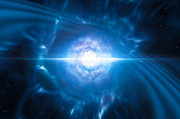Multi-messenger astronomy: visible detections of gravitational wave sources
 |
| Artist’s impression of two neutron stars merging |
In 2017 NASA/ESA Hubble Space Telescope helped to detect and studied the first visible counterpart to a gravitational wave source. This historic observation suggests that astronomers are seeing the result of the merger of two neutron stars. The cataclysmic aftermaths of this kind of merger — long-predicted events called kilonovae — disperse heavy elements such as gold and platinum throughout the Universe. This discovery also provides the strongest evidence yet that short-duration gamma-ray bursts are caused by mergers of neutron stars.
For the first time ever, astronomers have observed both gravitational waves and light (electromagnetic radiation) from the same event, thanks to a global collaborative effort and the quick reactions of telescopes both on the ground and in space. These observations mark the start of "multi-messenger" astronomy.